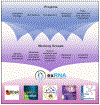The Extracellular RNA Communication Consortium: Establishing Foundational Knowledge and Technologies for Extracellular RNA Research
- PMID: 30951667
- PMCID: PMC6601620
- DOI: 10.1016/j.cell.2019.03.023
The Extracellular RNA Communication Consortium: Establishing Foundational Knowledge and Technologies for Extracellular RNA Research
Abstract
The Extracellular RNA Communication Consortium (ERCC) was launched to accelerate progress in the new field of extracellular RNA (exRNA) biology and to establish whether exRNAs and their carriers, including extracellular vesicles (EVs), can mediate intercellular communication and be utilized for clinical applications. Phase 1 of the ERCC focused on exRNA/EV biogenesis and function, discovery of exRNA biomarkers, development of exRNA/EV-based therapeutics, and construction of a robust set of reference exRNA profiles for a variety of biofluids. Here, we present progress by ERCC investigators in these areas, and we discuss collaborative projects directed at development of robust methods for EV/exRNA isolation and analysis and tools for sharing and computational analysis of exRNA profiling data.
Copyright © 2019 Elsevier Inc. All rights reserved.
Conflict of interest statement
DECLARATION OF INTERESTS
S.D. is a founding member of Dyrnamix, which has a patent on extracellular RNA biomarkers for cardiac remodeling. K.V.K.-J. is on the scientific advisory board for Dyrnamix. M.B. is a Clinical Advisor to Opsidio, LLC.
Figures

References
-
- Akat KM, Moore-McGriff D, Morozov P, Brown M, Gogakos T, Correa Da Rosa J, Mihailovic A, Sauer M, Ji R, Ramarathnam A, et al. (2014†). Comparative RNA-sequencing analysis of myocardial and circulating small RNAs in human heart failure and their utility as biomarkers. Proc. Natl. Acad. Sci. USA 111, 11151–11156. - PMC - PubMed
-
- Arroyo JD, Chevillet JR, Kroh EM, Ruf IK, Pritchard CC, Gibson DF, Mitchell PS, Bennett CF, Pogosova-Agadjanyan EL, Stirewalt DL, et al. (2011). Argonaute2 complexes carry a population of circulating microRNAs independent of vesicles in human plasma. Proc. Natl. Acad. Sci. USA 108, 5003–5008. - PMC - PubMed
Publication types
MeSH terms
Substances
Grants and funding
- UH3 TR000931/TR/NCATS NIH HHS/United States
- UH2 TR000875/TR/NCATS NIH HHS/United States
- UH3 TR000943/TR/NCATS NIH HHS/United States
- T32 AR059033/AR/NIAMS NIH HHS/United States
- R01 HL128996/HL/NHLBI NIH HHS/United States
- UH2 TR000931/TR/NCATS NIH HHS/United States
- U01 HL126493/HL/NHLBI NIH HHS/United States
- UH3 TR000901/TR/NCATS NIH HHS/United States
- UH2 TR000901/TR/NCATS NIH HHS/United States
- UH3 TR000906/TR/NCATS NIH HHS/United States
- UH2 TR000891/TR/NCATS NIH HHS/United States
- R01 HL145721/HL/NHLBI NIH HHS/United States
- P01 CA069246/CA/NCI NIH HHS/United States
- UH3 TR000921/TR/NCATS NIH HHS/United States
- UH2 TR000884/TR/NCATS NIH HHS/United States
- U01 HL126497/HL/NHLBI NIH HHS/United States
- UH2 TR000906/TR/NCATS NIH HHS/United States
- U19 CA179513/CA/NCI NIH HHS/United States
- UH3 TR000902/TR/NCATS NIH HHS/United States
- UH3 TR000875/TR/NCATS NIH HHS/United States
- UH2 TR000943/TR/NCATS NIH HHS/United States
- UH2 TR000890/TR/NCATS NIH HHS/United States
- UH2 TR000914/TR/NCATS NIH HHS/United States
- UH2 TR000921/TR/NCATS NIH HHS/United States
- UH2 TR000923/TR/NCATS NIH HHS/United States
- UH2 TR000928/TR/NCATS NIH HHS/United States
- UH2 TR000903/TR/NCATS NIH HHS/United States
- K24 HL137013/HL/NHLBI NIH HHS/United States
- R01 NS019108/NS/NINDS NIH HHS/United States
- UH2 TR000888/TR/NCATS NIH HHS/United States
- UH3 TR000914/TR/NCATS NIH HHS/United States
- U54 DA036134/DA/NIDA NIH HHS/United States
- UH3 TR000891/TR/NCATS NIH HHS/United States
- U19 CA179514/CA/NCI NIH HHS/United States
- U01 HL126496/HL/NHLBI NIH HHS/United States
- UH3 TR000918/TR/NCATS NIH HHS/United States
- U19 CA179564/CA/NCI NIH HHS/United States
- UH2 TR000880/TR/NCATS NIH HHS/United States
- U01 HL126495/HL/NHLBI NIH HHS/United States
- R01 DK100449/DK/NIDDK NIH HHS/United States
- UH2 TR000902/TR/NCATS NIH HHS/United States
- R01 AG041232/AG/NIA NIH HHS/United States
- U19 CA179563/CA/NCI NIH HHS/United States
- UH3 TR000890/TR/NCATS NIH HHS/United States
- UH3 TR000903/TR/NCATS NIH HHS/United States
- P30 DK020572/DK/NIDDK NIH HHS/United States
- U19 CA179512/CA/NCI NIH HHS/United States
- UH3 TR000928/TR/NCATS NIH HHS/United States
- UH3 TR000923/TR/NCATS NIH HHS/United States
- UH3 TR000888/TR/NCATS NIH HHS/United States
- UH2 TR000918/TR/NCATS NIH HHS/United States
- UH3 TR000933/TR/NCATS NIH HHS/United States
- U01 HL126494/HL/NHLBI NIH HHS/United States
- UH3 TR000884/TR/NCATS NIH HHS/United States
- UH2 TR000933/TR/NCATS NIH HHS/United States
- U01 HL126499/HL/NHLBI NIH HHS/United States
LinkOut - more resources
Full Text Sources
Molecular Biology Databases

